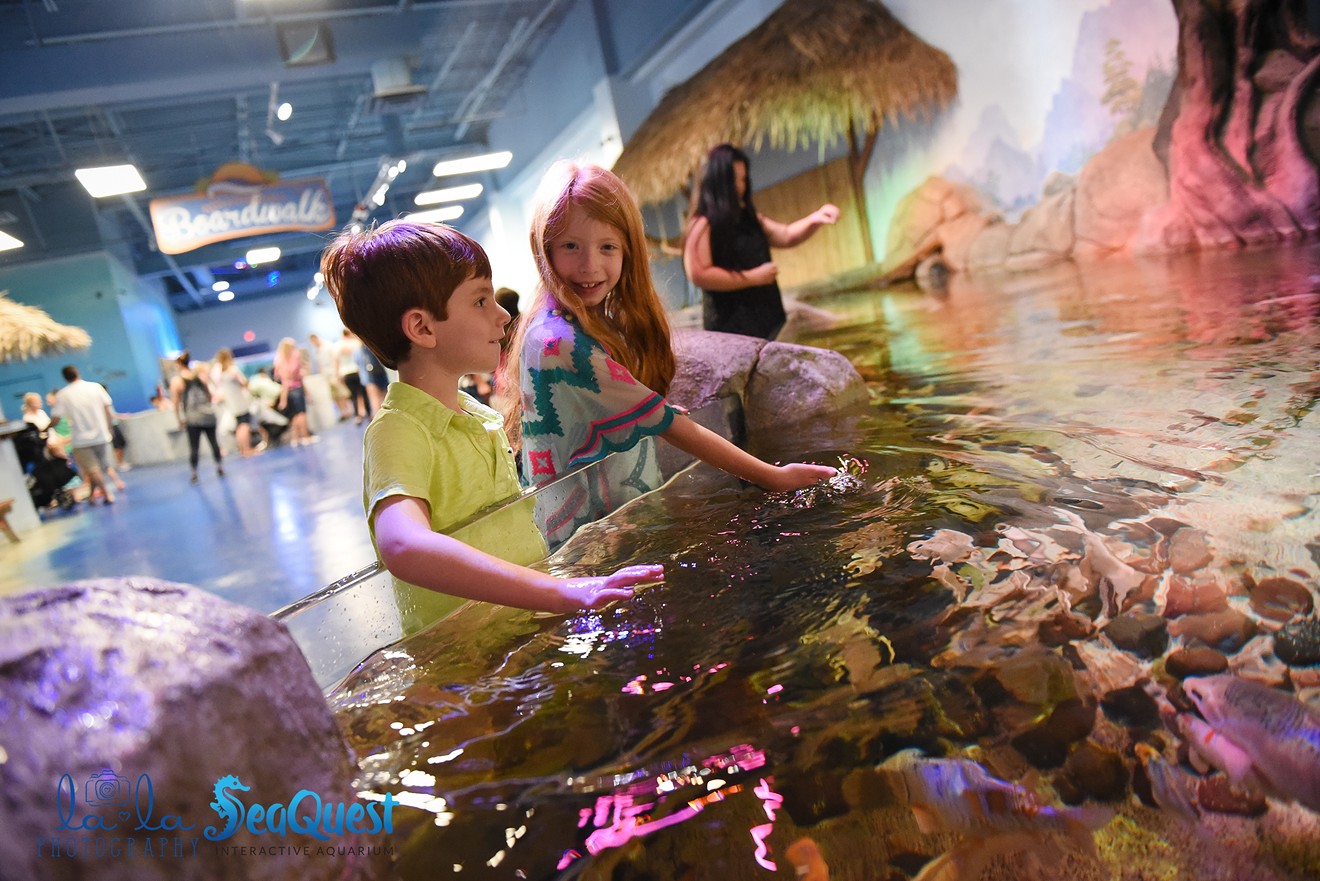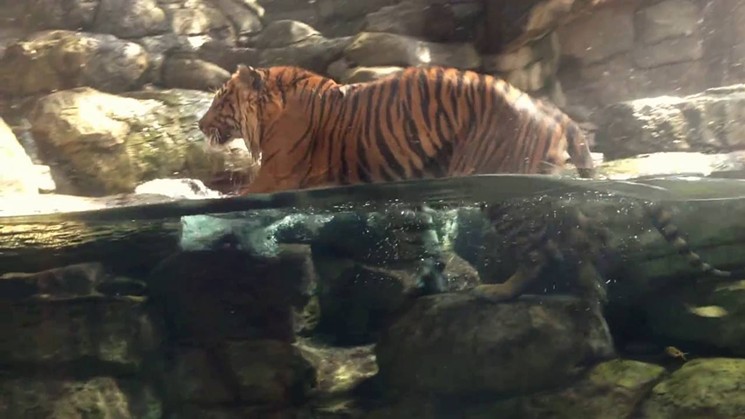The first thing you notice upon entering the Downtown Aquarium is the soundtrack. It’s loud — a combination of sloshing water, dolphin calls, bubbles popping, distant sea chanteys, and the occasional high-pitched sound effect you hear when you find treasure in a video game.
But you are not, of course, in some kind of digitized, pirate-filled, mermaid-populated aquatic wonderland. You are in the Mile High City, at a facility that started as Colorado’s Ocean Journey, which dried up when its funding did, and then was purchased for $13.6 million by Landry’s Restaurants (after a bidding war with Ripley’s). It reopened in 2005 as the Downtown Aquarium, a self-proclaimed “underwater adventure” that’s designed to educate you about real-life marine creatures. And let you eat some of them.
Still, questions flood in. Why are there plastic animals next to the real animals in an exhibit? Are you supposed to be able to hear the informational video about the endangerment of monk seals over the glimmering sounds of pirate treasure and children yelling? And, perhaps most important, why does the Denver area, which is 1,000 miles from the nearest ocean, now have not one, but two aquariums?
The SeaQuest Interactive Aquarium, a link in a for-profit chain that has five other locations in malls across the West, opened in Southwest Plaza in May, transforming a corner of the Littleton shopping complex into a winding pathway that beckons visitors to exhibits with names like Iguana Nirvana, Fantasy Cave and Icelandic Fishing Village, all to much the same soundtrack as that of the Downtown Aquarium (minus the sea chanteys and pirate treasure noises).
That’s not the only similarity. Both attractions are patronized primarily by families with young children and the occasional teenage couple on a date. Both are characterized by somewhat hokey theming directed toward kids, which tends to obscure the wonder of marine life in a marketing model that emphasizes adventure, fun and entertainment. Or “edutainment,” as SeaQuest Marketing Director Elsa MacDonald calls it. And in both, the emphasis seems to have fallen more on the “entertainment” side of things, with a whole lot of aquatic lore and relatively little detailed information about most of the animals kept inside. Still, the lure of the sea on a long, hot, dry summer day can be difficult to fight. So if you’re determined to take the plunge, here’s our guide to where you’ll land the most satisfying experience.
You have small children who really, really want to touch animals: SeaQuest
SeaQuest bills itself as an “interactive aquarium,” and it lives up to this billing. After paying the admission price of $14.95, visitors can also purchase tokens (four for $9.50) that allow them to feed various animals along their journey. They can also pet otters, turtles and stingrays (the latter option is also offered at the Downtown Aquarium).
An especially entertaining experience (to watch) is the feeding opportunity at SeaQuest’s Parakeet Paradise and Lorikeet Landing. Here visitors can exchange a few tokens for small cups of bird feed, which they are instructed to hold in their laps as tropical birds swarm onto their arms. It’s difficult to determine who should be more afraid: the small children, who seem at risk of being pecked into oblivion, or the smaller birds, who’re definitely in danger of getting accidentally trampled. Nonetheless, most kids scream in what at least appears to be delight.
Both aquariums also offer more adventurous activities, such as the “Shark Cage Experience” at the Downtown Aquarium, where visitors ages eight and up can pay $100 to swim with sharks in the Shipwreck exhibit (after already forking over $20.99 for admission), or the “Sleep With Sharks” experience at SeaQuest, where groups can book the aquarium for a night of “sweet dreams followed by a continental tank-side breakfast” ($1,000 for a group of fewer than forty people).
You believe that mermaids are real: Downtown Aquarium
Following a country-wide trend, both aquariums boast “real” mermaids. SeaQuest hosts a mermaid named Marina, who is available to tell children stories, pose for selfies and sell what she calls “special dolls” with her image on them, in a style reminiscent of many mall Santa Clauses. The Downtown Aquarium offers a more active, exciting display, with mermaids free-diving into a fish-filled pool in front of restaurant patrons. Depending on where you stand on the issue of mermaid existence, watching these mermaids hold their breath while smiling and waving at the crowd is either enthralling or nerve-racking.
You’re not exactly sure what counts as an “aquatic” animal: SeaQuest
The dictionary definition of “aquarium” is “a transparent tank of water in which fish and other water creatures and plants are kept.” It’s not exactly clear when aquariums started expanding that definition to include any glass container populated by any type of living organism, but nonetheless, non-aquatic animals abound at both Denver attractions. Scorpions and spiders are one thing, but the Downtown Aquarium is also home to three endangered Sumatran tigers, which were given to the facility as part of a conservation program run by the Association of Zoos and Aquariums. These large carnivorous mammals, part of the “rainforest” exhibit, are thankfully not submerged in water...but they are kept together in a small indoor space, despite an exhibit sign that notes “tigers are solitary animals, living almost their entire life alone.”
Two twelve-year-olds pointed out this fact in a 2016 petition that garnered over 6,000 signatures in support of moving the tigers to a wildlife reserve. But they’re still here.
So far, no one has petitioned for the removal of SeaQuest’s wallabies, sloths, snakes or various reptiles and birds.
You may not love looking at animals, but you do love looking at people looking at animals: Tie
It turns out that coming face-to-face with bizarre deep-sea creatures prompts onlookers to do equally bizarre things, especially when there’s not much staff oversight visibly present. At the Downtown Aquarium, one teenage boy pounded on the outside of the aquarium walls, sending fish swimming the other way as his girlfriend took photos to make it look like he was trapped (the irony). The Downtown Aquarium is also a great place to pick up on “what-not-to-do” parenting techniques. Case in point: After a father was overheard taunting his young son, Hunter, by asking, “Want to ride the tiger?,” Hunter jumped on top of the glass cover of a starfish exhibit, tipping it over and exposing the starfish for a brief second. (His dad discreetly put the glass back in place.)
At SeaQuest, a girl was seen begging her parents to enter Parakeet Paradise for a third time before they resorted to bribing her with a selfie with a “real” mermaid.
You want to (kind of) support marine wildlife conservation efforts: Downtown Aquarium
Unlike SeaQuest, the Downtown Aquarium is certified by the Association of Zoos and Aquariums, which means it must adhere to certain standards of animal management and care, as well as be involved in conservation and education. The Downtown Aquarium also partners with organizations such as Ocearch and the National Marine Fisheries Service on fundraising projects and exhibits that educate visitors on conservation efforts.
While SeaQuest claims to support conservation by exposing visitors to other species, the company is not affiliated with any marine wildlife conservation group. In 2017, a SeaQuest employee told the Las Vegas Review Journal that hundreds of animals had died in the care of that city’s aquarium. SeaQuest denied the allegations.
You want to learn more about marine ecosystems: Read a book.
While a visit to either of these attractions can definitely be entertaining, you can only learn so much from signs with a few facts about only a few of the animals on display. As a result, any visitor looking for a better understanding of deep-sea life might be left feeling high and dry.
[
{
"name": "Air - MediumRectangle - Inline Content - Mobile Display Size",
"component": "12017618",
"insertPoint": "2",
"requiredCountToDisplay": "2"
},{
"name": "Editor Picks",
"component": "17242653",
"insertPoint": "4",
"requiredCountToDisplay": "1"
},{
"name": "Inline Links",
"component": "18838239",
"insertPoint": "8th",
"startingPoint": 8,
"requiredCountToDisplay": "7",
"maxInsertions": 25
},{
"name": "Air - MediumRectangle - Combo - Inline Content",
"component": "17261320",
"insertPoint": "8th",
"startingPoint": 8,
"requiredCountToDisplay": "7",
"maxInsertions": 25
},{
"name": "Inline Links",
"component": "18838239",
"insertPoint": "8th",
"startingPoint": 12,
"requiredCountToDisplay": "11",
"maxInsertions": 25
},{
"name": "Air - Leaderboard Tower - Combo - Inline Content",
"component": "17261321",
"insertPoint": "8th",
"startingPoint": 12,
"requiredCountToDisplay": "11",
"maxInsertions": 25
}
]














